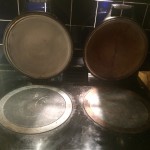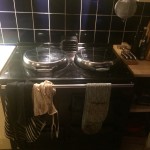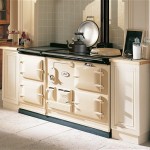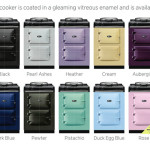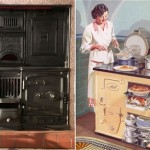My house sold itself in so many ways, but one of the prime selling points was the Aga range. The foodie in me instinctively fell for this vast lump of cast iron and stainless steel on sight. It was irresistible – an item of beauty but also iconic, a true item of kitchen heritage, something with a reassuringly solid and permanent feel. Like a classic timepiece, it felt like I would not be owning the Aga but minding and cherishing it for the next owners, and the ones after that. If I could come back a Century later, there it would be, still churning out heat and great dishes.
Bearing in mind that I moved in on a snowy December day, the fact that the Aga was always on, pumping out heat, was truly a blessing. When I got the cats from a nearby rescue centre a few months later, they also appreciated the constant warmth – though at times it got too hot for them. In winter, I often have a furry rug laid out at the base of the Aga, which does at least mean that the heat is not going to waste!
Range stoves have been around a very long time, though the Aga first saw light of day in the 20th Century. From Wikipedia:
Gustaf Dalén lost his sight in an explosion while developing his earlier invention, a porous substrate for storing gases, Agamassan. Forced to stay at home, Dalén discovered that his wife was exhausted by cooking. Although blind, he set out to develop a new stove that was capable of a range of culinary techniques and easy to use.
Adopting the principle of heat storage, he combined a heat source, two large hotplates and two ovens into one unit: the AGA Cooker. The cooker was introduced to England in 1929, and its popularity in certain parts of English society (owners of medium to large country houses) led to the coining of the term “AGA Saga” in the 1990s, referring to a genre of fiction set amongst stereotypical upper-middle-class society.
Whether they are able to heat the house is a moot point:
Aga cookers can also make a contribution to space heating, although it is not true that they can heat an entire house, despite persistent claims to the contrary, presumably arising because the cookers look similar to the many types of central-heating range such as the ‘Stanley’ or the ‘Rayburn‘ Range, also made by the AGA Rangemaster Group.
Trust me, since warm air rises the impact on my house is phenomenal. In winter that is fine and dandy, but in summer that means that the house is like a tropical greenhouse – the reason why many people choose to turn their Agas off in high season, and why many sizeable country kitchens are equipped with a regular hob and oven in addition to the Aga. In my case, turning off the Aga would leave me with a multi-function microwave (oven, grill etc.), a George Foreman grill, a slow cooker and an electric wok. It’s doable to cook dinner, but less than ideal – hence my usual practice of keeping the Aga on, other then when down for maintenance or repair.
The big downside to all this is cost, quite apart from purchase price – which did not affect me since the Aga came with my house. The big deal is running costs, on which these are the wise words from Wikipedia:
AGAs have recently been criticised for their high energy consumption and inefficiency. A small, traditional two-oven AGA running on gas will use approximately 425 kWh per week (22,100 kWh per year; perhaps half that if switched off during the summer months). The average standard gas oven and hob uses 580 kWh during a year, only 2.62% of the AGA’s consumption. AGA’s own figures for expected energy consumption for their two-oven AGA support this criticism, suggesting a weekly consumption of 40 litres of kerosene or diesel, 60 litres of propane gas, 425 kWh of natural gas or 220 kWh for the electric models. This would indicate that the smallest traditional two-oven gas AGA providing simple cooking functions (i.e. no water heating or central heating) consumes almost as much gas in a week as a standard gas oven/hob does in nine months.
Aga themselves have stepped into this debate with their own argument about running costs (see here), and other sites make a reasoned attempt to justify the cost of fuel from leaving the stove running all the time (see here.) Also from Wikipedia:
Owners often talk about how the AGA actually makes their homes more energy efficient, as the AGA does a number of jobs, such as replacing several radiators, and is not simply a cooker. They also use the fact that it is made from recycled materials and claimed to last for at least half a century to back this up.
The vast majority of AGAs sold today are programmable and AGA announced an upgrade initiative in 2009, meaning that owners of older AGA cookers can have them modified so they are programmable. The latest model, the AGA Total Control, uses the same radiant heat to cook (without drying the food out), but is designed to be switched off like a regular cooker when not in use, using far less energy as a result.
But the fact is that they do cost a lot to run, whether you use electricity, gas, oil or solid fuel. I once estimated mine to cost me about £20 a week in gas, but for the benefits I think it a price worth paying – and it’s all about the cooking. Yes, I do have an annual maintenance charge, but it costs much less than Aga doing it, since the guy I use is an ex-Aga engineer. Worth getting to know the experts!
The plus side is simple: no wasted energy in heating up the stove, because it’s always on, and no fan because it radiates heat from all sides. No switches or controls because you don’t need them. The only thing to remember is to keep an eye on what you’re cooking, since it will typically cook a lot quicker on an Aga.
In fact, I never did get why people consider cooking on an Aga daunting – all you have to do is move your pans around so you get the right temperature. The absence of a grill is not a problem since you can put anything on the shelf at the top of the roasting oven – trust me, it will brown to perfection. You can even get a toasting accessory (which I don’t have), which I’m told makes the best toast ever.
I’d have loved a wok-burner and a griddle plate, but needs must – just choose a flat-bottomed pan to do your stir-fries, rather than a conventional wok. For the most part, any solid-bottomed cookware than diffuses heat evenly works just fine on the hotplate, but then I would always recommend cooking with top notch cookware on any cooker. If you can afford a few Le Creusets, they work a treat – but then I also have great results with copper-bottomed stainless steel pans that came from, whisper it, Sainsburys!
I have two hobs (boiling and simmering plate respectively) and two ovens (roasting and warming.) Since the plates are big enough to accommodate several pans, there is rarely a capacity issue, though of course the point of an Aga is really the ovens. I’ve cooked for a dozen without any problem.
The roasting oven roasts, grills (see above) and cooks to a temperature typically in the region of 200-250c, so all my meats and fish dishes are cooked evenly to a crisp. But the real star is the warming oven, which at times warms my plates and acts as a fine location to keep meat while it’s resting.
It is however simply the best for cooking long, slow casseroles, pot roasts, and even my famed 24 hour shoulder of pork. Fat is rendered and the meat is incredibly moist and tender. I mentioned the slow cooker, but with the slow oven you hardly ever need one – the Aga does it to perfection.
For the house proud among you, the enamel can be a bit tough to clean, but the plates will burn away anything that drops on them. It’s not difficult to render sparkling the beautiful range, which, let’s face it, looks a damn sight more appropriate in a country kitchen than your box standard ovens and hobs – and they come in a range of colours too, so if you were choosing one from scratch it would be akin to running down the colour charts in a car showroom or a DIY place – paint your kitchen to blend in with your Aga! Mine is midnight blue, matched by kitchen tiles in the same colour.
I can understand how this option would not suit everybody, but it is a gorgeous way to cook if, like me, you are a true foodie.


